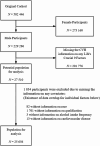Association of life's crucial 9 score with benign prostatic hyperplasia: a cross-sectional study
- PMID: 40390049
- PMCID: PMC12090484
- DOI: 10.1186/s41043-025-00925-z
Association of life's crucial 9 score with benign prostatic hyperplasia: a cross-sectional study
Abstract
Background: Benign prostatic hyperplasia (BPH) and prostate cancer (PCa) are prevalent prostate diseases in aging male populations, with significant implications for quality of life and healthcare burden. While cardiovascular health (CVH) and lifestyle factors have been linked to aging and chronic diseases, their association with prostate diseases remains underexplored.
Objective: This study investigates the relationship between CVH, assessed using the Life's Crucial 9 (LC9) score, and the risk of prostate diseases, including BPH and PCa, in a large UK cohort.
Methods: Data from 26,656 male participants in the UK Biobank were analyzed. The LC9 score, an expanded CVH metric incorporating mental health, was calculated based on physical, metabolic, and psychological factors. Logistic regression and restricted cubic spline analyses were performed to examine associations between the LC9 score and prostate diseases. Subgroup and interaction analyses were conducted to explore potential modifiers.
Results: A higher LC9 score was significantly associated with a lower risk of BPH in both continuous and categorical models (P < 0.001). The association demonstrated a linear dose-response relationship, with the inflection point at an LC9 score of 72.5. Subgroup analysis revealed stronger protective effects in participants with lower socioeconomic deprivation. However, no significant association was observed between the LC9 score and PCa risk, even in subgroup analyses.
Conclusions: This study highlights the importance of overall cardiovascular and psychological health in reducing BPH risk, emphasizing the need for sustained healthy behaviors. The absence of a significant link between the LC9 score and PCa suggests distinct pathophysiological mechanisms and warrants further research. These findings provide valuable insights for targeted prevention and management strategies in prostate health.
Keywords: Cardiovascular health; Lifestyle factors; Prevention; Prostate diseases.
© 2025. The Author(s).
Conflict of interest statement
Declarations. Ethics approval and consent to participate: The ethical approval for the UK Biobank research was granted by the North West Multicenter Research Ethical Committee, and written informed consent was obtained from all the participants during the baseline recruitment to the UK Biobank. This current study was specifically approved by the UK Biobank under application number 332912. Consent for publication: The authors consent to the publication of the submitted manuscript. Competing interests: The authors declare no competing interests.
Figures
Similar articles
-
Higher Life's Crucial 9 protects against infertility among U.S. women aged 18-45 years.Front Endocrinol (Lausanne). 2025 Jan 30;16:1465022. doi: 10.3389/fendo.2025.1465022. eCollection 2025. Front Endocrinol (Lausanne). 2025. PMID: 39950025 Free PMC article.
-
Association between life's crucial 9 and lung health: a population-based study.BMC Pulm Med. 2025 May 3;25(1):213. doi: 10.1186/s12890-025-03684-z. BMC Pulm Med. 2025. PMID: 40319236 Free PMC article.
-
The association between life's crucial 9 and all-cause, cancer-specific and cardiovascular mortality in US cancer survivors: a cohort study of NHANES.BMC Cancer. 2025 Apr 30;25(1):805. doi: 10.1186/s12885-025-14229-2. BMC Cancer. 2025. PMID: 40307773 Free PMC article.
-
Review of the role of androgenic hormones in the epidemiology of benign prostatic hyperplasia and prostate cancer.Urology. 1994 Jun;43(6):892-9. doi: 10.1016/0090-4295(94)90163-5. Urology. 1994. PMID: 7515207 Review.
-
Is there evidence of a relationship between benign prostatic hyperplasia and prostate cancer? Findings of a literature review.Eur Urol. 2009 Apr;55(4):864-73. doi: 10.1016/j.eururo.2008.11.011. Epub 2008 Nov 21. Eur Urol. 2009. PMID: 19027219 Review.
References
-
- Li B, Chen C, Chen Z, et al. Epidemiological investigation of sex hormones and their metabolism-related gene single nucleotide polymorphisms in patients with benign prostatic hyperplasia complicated with late-onset hypogonadism: a retrospective cohort study. Int J Surg. 2024;110(12):7840–51. 10.1097/JS9.0000000000001557. - PMC - PubMed
-
- Chesnaye NC, Ortiz A, Zoccali C, Stel VS, Jager KJ. The impact of population ageing on the burden of chronic kidney disease. Nat Rev Nephrol. 2024;20(9):569–85. 10.1038/s41581-024-00863-9. - PubMed
-
- Frendl DM, Chou WH, Chen YW, Chang DC, Kim MM. Early vs delayed transurethral surgery in acute urinary retention: does timing make a difference?? J Urol. 2023;210(3):492–9. 10.1097/JU.0000000000003559. - PubMed
-
- Delgado J, Porto JG, Bhatia A, et al. Functional outcomes of single-session holmium laser enucleation of the prostate and high-intensity focused ultrasound in management of patients with prostate cancer and enlarged prostate: results from a pilot study. World J Urol. 2024;43(1):53. 10.1007/s00345-024-05424-0. - PMC - PubMed
MeSH terms
Grants and funding
LinkOut - more resources
Full Text Sources
Medical



